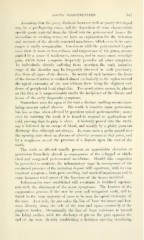Page 519 - My FlipBook
P. 519
GOUTY PERICEMENTITIS. 517
Assuming that the gouty diathesis however well or poorly developed
may be a predisposing cause, and the deposition of some characteristic
specific gouty material from the blood into the pericemental tissues the
immediate or exciting cause, we have an explanation for the irritation
and necrosis of the alveolo-cemental membrane, Avhich even in its early
stages is easily recognizable. Coexistent with the ])ericemental hyper-
emia there is more or less redness and turgescence of the gums, accom-
panied by a sense of tenderness, soreness, and in many cases neuralgic
pain, which latter symptom frequently precedes all other symptoms.
In individuals already suffering from pyorrhea, the early irritative
stage of the disorder may be frequently observed in teeth previously
free from all signs of the disease. In nearly all such instances the focus
of the diseased action is confined almost exclusively to the region toward
the apical extremity of the root without there being the slightest evi-
dence of peripheral local gingivitis. Too much stress cannot be placed
on this fact, as it unquestionably marks the incipiency of the disease and
is one of the early diagnostic symptoms.
Somewhere near the apex of the root a distinct swelling occurs simu-
lating an acute apical abscess. The tooth is sensitive upon percussion,
but less so than when affected by purulent apical pericementitis ; more-
over by isolating the tooth it is found to respond to applications of
cold, proving that its pulp is alive. A bistoury passed into the swell-
ing is followed by an escape of blood, and usually by a glairy purulent
discharge also, although not always. In some cases a probe passed into
the opening may show an absence of alveolar process at that point, and
by a roughness reveal the presence of a deposit upon the root of the
tooth.
The teeth so affected usually present an appreciable elevation or
protrusion from their alveoli in consequence of the enlarged or thick-
ened and congested pericemental membrane. Should this congestion
be permitted to continue, the inflammatory stage in consequence of the
continued presence of the irritating deposit will supervene, with its con-
comitant symptoms, heat, pain, swelling, and marked impairment and in
some instances total arrest of the functions of the tissues involved.
Inflammation once established will eventuate in localized suppura-
tion with the abatement of the acute symptoms. The location of the
suppurative })rocess, if the case be seen and recognized early, will be
found in the large majority of cases to be near the apical extremity of
the root. As a rule, the pus takes the line of least resistance and bur-
rows directly along the side of the root and opens externally at the
gingival liorder. (Occasionally the line of least resistance is toward
the labial suriace, with the discharge of pus on the gum opposite the
end of the root, thereby establishing a fictitious oj>ening simulating


